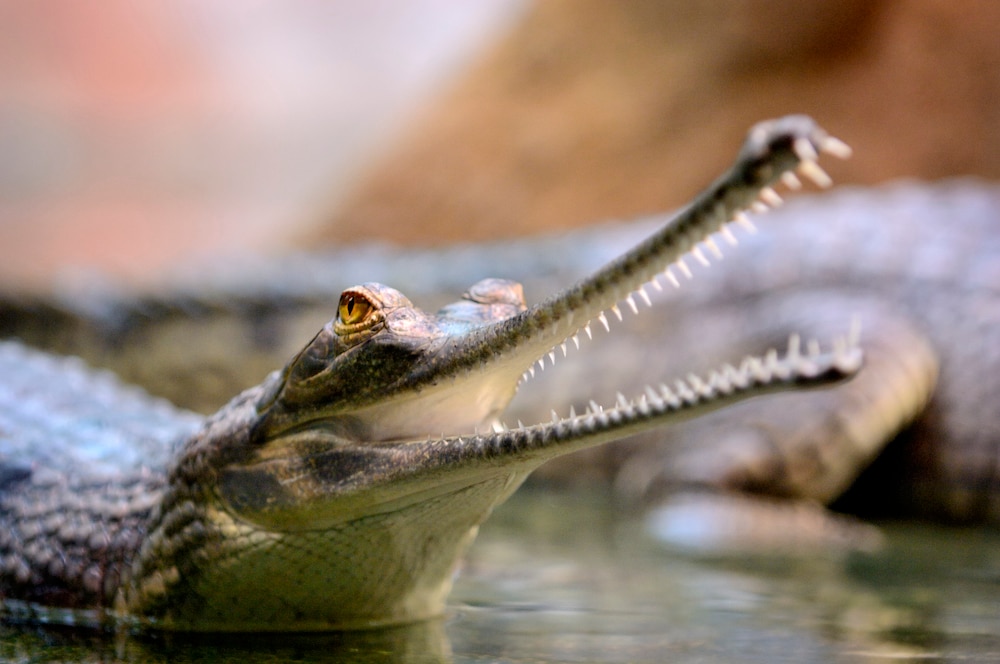Create a free profile to get unlimited access to exclusive videos, sweepstakes, and more!
That’s going to need a lot of tissues — some crocodiles have the same nasal issues we do
Gharials have a deviated septum like humans, only worse. Blame it on their bizarre elongated snouts.

Humans have been suffering from a deviated septum just about as long as humanity existed, but our species has it easy compared to the gharial.
Gharials (Gavialis gangeticus) are endangered crocodilians with such a long and narrow snout that it often gets in the way of their breathing. When a human nose has a deviated septum — a common bane of our existence — part or all of it can be crushed on one side and interfere with an airway. That explains why it can be difficult to breathe for someone who has a severe form of this condition, and why sinus infections can be murder.
Unlike us, gharials can’t just go get reconstructive surgery to make their often punishing septal deviation more bearable. While some can get away with a moderate case, others are plagued by it, but most somehow end up surviving even though they can barely breathe. Researcher Jason Bourke of NYIT, working with colleagues at Arkansas State University, became so fascinated with these creatures that he had to find out what was going wrong in their bizarre snouts. He led a study recently published in The Anatomical Record.
“Evolving thinner snouts made gharials able to quickly move their jaws through the water and snap up fish without giving away their position,” Bourke told SYFY WIRE. “However, very thin partitions like this don't take much to get out of alignment, which is why gharials seem particularly susceptible to nasal septum deviations.”
Though evolution usually works in favor of an organism, there is sometimes a trade-off. Early gharials are thought to have started out with broader snouts like extant alligators and crocodiles. The advantage these species have is not only a nasal septum with two channels (like ours) that allows them to gauge where the smell of prey is coming from, but their snouts are also robust enough to pull off the dreaded death roll they often use to take down large prey, often seen on nature documentaries. Gharials can’t do that.
For such a narrow snout, gharial jaws are unexpectedly strong, but while they can sink their teeth into a hapless fish, they often break their snouts fighting with each other. They also have only one nostril. There is so little real estate in there that the septum has to bend back and forth, forming a wavy structure that can often make gharials gasp for air. An especially rough case of obstruction was found in a specimen at the Fort Worth Zoo. “Louise” had such a warped septum that she may have not survived in the wild.
“When we ran 3D models of gharial noses through our simulation software, we saw their nasal septum is not only thinner than other crocodilians, but also shorter in some ways,” Bourke said. “Having a single nostril means gharials probably couldn't detect the direction of odors very well.”
Louise probably made it to the ripe old (for a gharial) age of 50 because she lived at the zoo and didn’t have the burden of hunting. Bourke thinks gharials could end up losing their nasal septum completely. They spend so much more time in the water than any other crocodilians that they aren’t even able to hold themselves up on their legs. Hanging out underwater for so long means your airway is going to be shut, so that demands a larger airway rather than the ability to trace where smells are coming from.
Though gharials share some features with other crocodilians, like an olfactory region that only allows air to go in one direction for detecting smells, the similarities end there. Louise was found to have had such a limited flow of air to her lungs that she had to really work to get enough oxygen. Bourke thinks such effort put pressure on the lining of her nose, so she was more prone to having nosebleeds, and particularly awful ones at that. Can you even imagine how many tissues a gharial would need for that?
“Gharials come from a long line of animals that are used to taking a lot of punishment,” he said. “Even males that break half their snouts in a fight can survive for a long time afterwards and not succumb to disease because of the newly opened wound. Such natural bomb-proofing likely helps animals with pathologies like these.”
Another thing the strangely elongated snouts of these creatures revealed is that the weird sounds they make might share space inside that already cramped nose. The ghara is a bulbous structure at the end of the snout that is still something of a mystery, but air being pushed through causes vibrations that make a sort of buzzing sound, especially in males. Near the throat is a bulge called the pterygoid bulla. Behind this structure are enlarged bones in the nose, and it makes a sound like popping a cork.
Bourke also believes it is possible that some dinosaurs with long noses, such as Parasaurolophus, possibly suffered from a deviated septum. So if you think you have it bad when it’s allergy season or cold and flu season, just think of a huge reptile reaching for a gargantuan box of tissues.


























